
How to prepare a no-till garden bed in one month or less
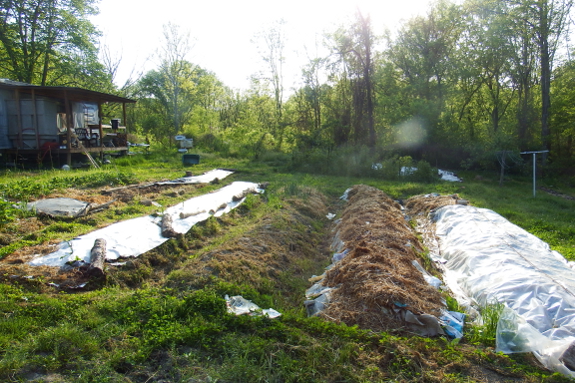
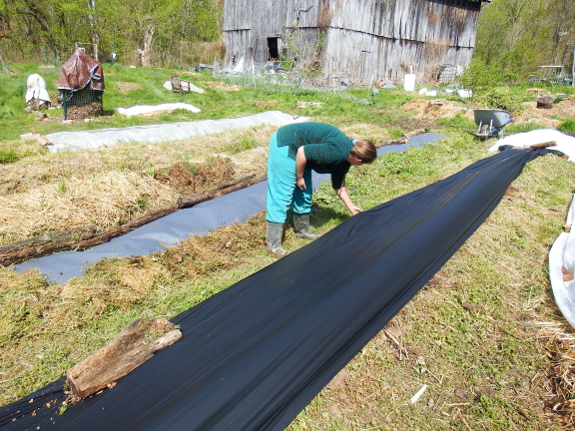
Option A involved a type of very thin, biodegradable black plastic.
The photo above shows Kayla helping me lay down the plastic three weeks
ago. The photo below shows completely dead oats underneath the plastic
this past Thursday.
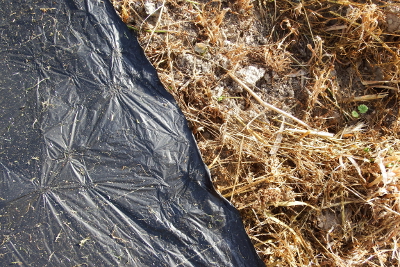 This
product worked much faster than I thought it would, probably because
we've had crazy summer weather in April and early May (highs up to 90
some days), which surely heated up the soil underneath very quickly.
This
product worked much faster than I thought it would, probably because
we've had crazy summer weather in April and early May (highs up to 90
some days), which surely heated up the soil underneath very quickly.
On the down side, all it took was Huckleberry walking across the plastic
to tear little holes, which a light wind quickly turned into long
tears. (I'm telling you Huckleberry really isn't that big of a cat!) So,
although effective, I'd caution against using this product anywhere
that pets will be walking even a little bit.
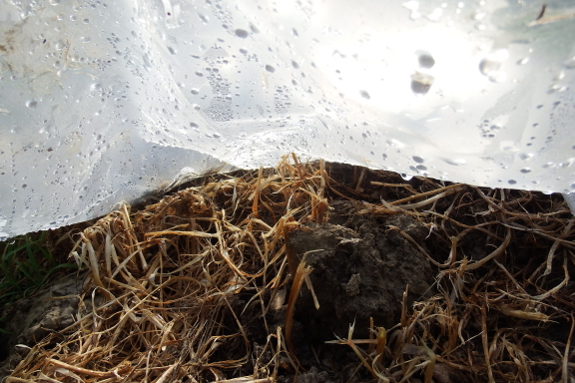
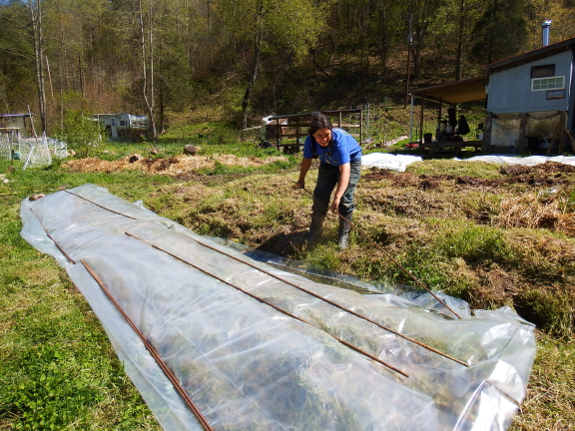 Option 2 was solarization, which I explained in more depth in this post.
The solarization worked about equally as fast as the black plastic,
with the bonus that this clear plastic didn't shred after light pet
traffic. The clear plastic also held in the soil moisture, which was
handy since rainfall for the last few weeks has been nearly nonexistant.
Option 2 was solarization, which I explained in more depth in this post.
The solarization worked about equally as fast as the black plastic,
with the bonus that this clear plastic didn't shred after light pet
traffic. The clear plastic also held in the soil moisture, which was
handy since rainfall for the last few weeks has been nearly nonexistant.
The downside of
solarization is that my raised beds in this area are tall enough that
the north-facing side of the bed didn't heat up fully, so the oats
underneath the plastic on that side are still somewhat green. So if you
plan to use solarization to prepare soil, you'll want to stick to areas
where the ground is as flat as possible. With that caveat and assuming
hot weather, you can also plant into solarized ground in about three
weeks if your weeds are only moderatly tenacious. (Add a few more weeks
for both Option A and Option B if you're trying to kill a wily perennial
like wiregrass.)
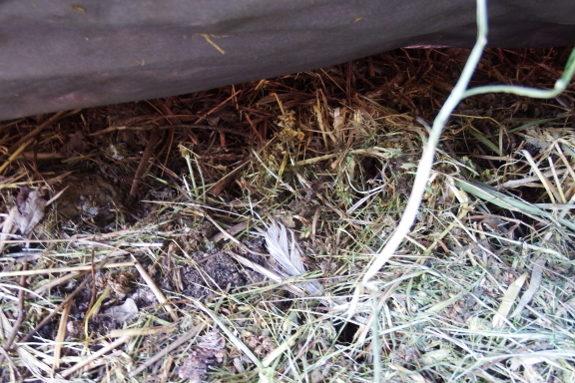
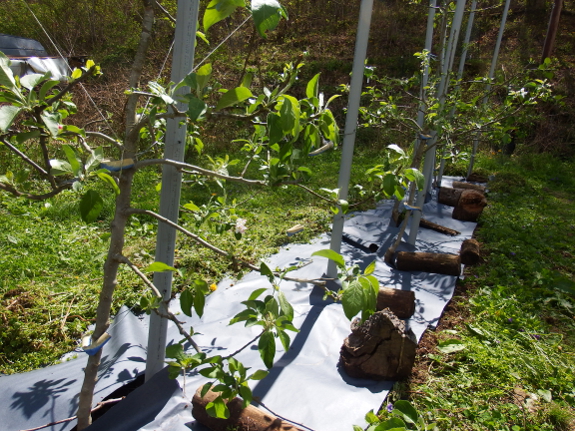 Option 3 was a storebought roll of paper mulch.
This mulch was the least effective as a fast weedkill, although it
looks to be the most effective as a long-term ground cover.
Option 3 was a storebought roll of paper mulch.
This mulch was the least effective as a fast weedkill, although it
looks to be the most effective as a long-term ground cover.
As Mark mentioned,
the first rain bleached the dye out of the paper, and the lighter color
left behind meant that the mulch simply acted like a barrier between
the weeds and the sun rather than heating the soil underneath. The
result is that the weeds beneath the paper mulch aren't quite dead yet,
although the paper is still providing a good barrier around the
high-density apple trees. I suspect I'll need to wait about 4 to 6 weeks
between laying down this mulch over an oat cover crop and planting into
the bare soil.
As another downside, Lucy running across the mulch did
poke holes in the paper layer, allowing some weeds to come up through.
That said, the paper has much more structural integrity than the very
thin black plastic, so only the paw-print areas were affected rather
than the whole sheet of mulch. So I'd say the plastic mulch is
acceptable over areas with light pet traffic.
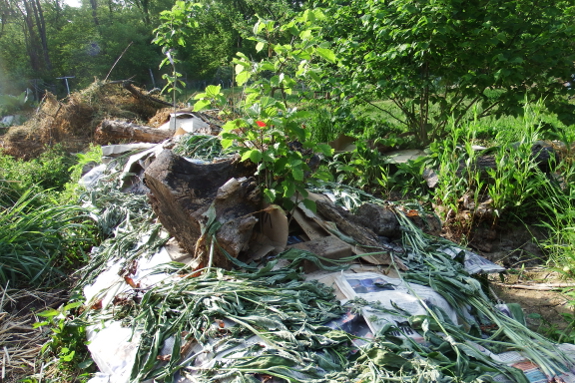
Option 4 was mad of
entirely free materials, but I didn't lay them down until later than the
previous options and thus don't have a comparison yet to the other
methods. Kayla's father came through with a big box of newspaper
(thanks, Jimmy!), and I've been applying the sheets using different
methods in different parts of the garden.
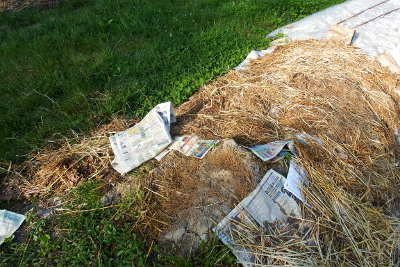 The
photo to the left shows how I laid the paper down dry and then anchored
it with deep-bedding material from the goat coop. Unfortunately, some
of the sheets have blown away, which is why I started soaking the paper
in a bucket of water before applying.
The
photo to the left shows how I laid the paper down dry and then anchored
it with deep-bedding material from the goat coop. Unfortunately, some
of the sheets have blown away, which is why I started soaking the paper
in a bucket of water before applying.
The top photo in this
section shows some newspaper-mulched areas around the hazelnut bushes.
Since I have comfrey plants growing along the aisles in that part of the
garden, it was easy to yank handfuls of the greenery as a short of chop-'n-drop
to weigh the wetted newspapers down. I'll post a followup in a few
weeks once I know more about how the newspaper mulches compare to the
other methods, but my guess is that they'll be comparable to the
storebought paper mulch.
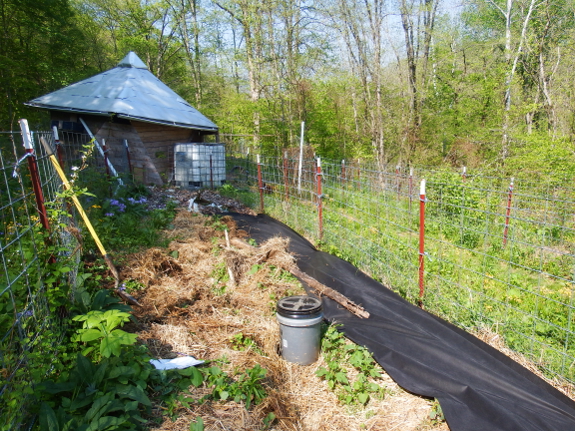
The final method I'm trying is a more long-lived type of black plastic
that is supposed to be good for 12 years (assuming you don't puncture
the fabric in the interim). I laid down an experimental span in the
proto-tree-alley a week ago, with the plan of taking up the plastic at
the end of the month and planting sweet potatoes there. I'll keep you
posted about weed control there as well.
Phew! I know that's a lot
of data, but I hope it'll help you decide on a weed barrier that'll fit
your particular garden needs. And perhaps there's another method I
haven't considered that you've used with success in your garden? Be sure
to let me know in the comments!
Want more in-depth information? Browse through our books.
Or explore more posts by date or by subject.
About us: Anna Hess and Mark Hamilton spent over a decade living self-sufficiently in the mountains of Virginia before moving north to start over from scratch in the foothills of Ohio. They've experimented with permaculture, no-till gardening, trailersteading, home-based microbusinesses and much more, writing about their adventures in both blogs and books.
Want to be notified when new comments are posted on this page? Click on the RSS button after you add a comment to subscribe to the comment feed, or simply check the box beside "email replies to me" while writing your comment.

Anonymous --- I'll look forward to seeing how your results compare to mine!
Justus --- All of the creeping grasses are a tricky topic, and I haven't really figured out the solution yet. On the one hand, I'm not sure tilling helps that much since I've read it breaks the roots up into smaller pieces so you get a lot more grass. But on the other hand, the beds I have where those grasses are trying to invade are a pain in the butt to weed by hand and require twice the attention of the other beds. Kill mulches help (cardboard covered by straw), but they're not a cure-all.
Jonathan --- Yeah, I'm especially concerned about the methods that heat up the soil. I'll be growing veggies in all of these beds in June, so I'll report back if I notice that some result in healthier plants than others. Time will hopefully tell....